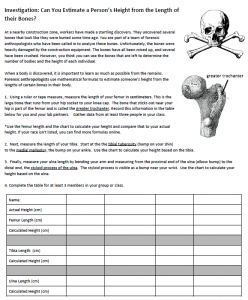
In this activity, students use tape measures to estimate the length of their femur, ulna, and tibia. Measure the femur from the hip to medial malleolus of the ankle. Then measure the ulna from the elbow protrusion to the styloid process (the little bump on the wrist). Measure the tibia from the tibial tuberosity to the lateral malleolus.
Record these lengths and then use an equation to estimate height which can then be prepared to their actual height. To estimate height based on the femur, measure the length of the femur in centimeters and use a formula to calculate the estimated height. The formula takes into account the sex of the person, as this affects the calculation of height
For example, to estimate the height of a female, multiply the length of the femur by 2.47 and add 54.1, while for a male, multiply by 2.32 and add 65.53. Handout includes a chart and formula for calculations.
The instructions include terminology specific to those bones, such as greater trochanter, styloid process, and tibial tuberosity.
I use this activity as an introduction to the lab where students examine real bones of a disarticulated skeleton. They can use the same formulas to estimate the size of the skeletons in the lab.
The second part of this worksheet provides measurements from bones found at a construction site. Students use the same formulas to determine if the bones came from the same person or if there were multiple bodies at the construction sites.

Grade Level: 9-12
Time Required: 30-40 minutes

